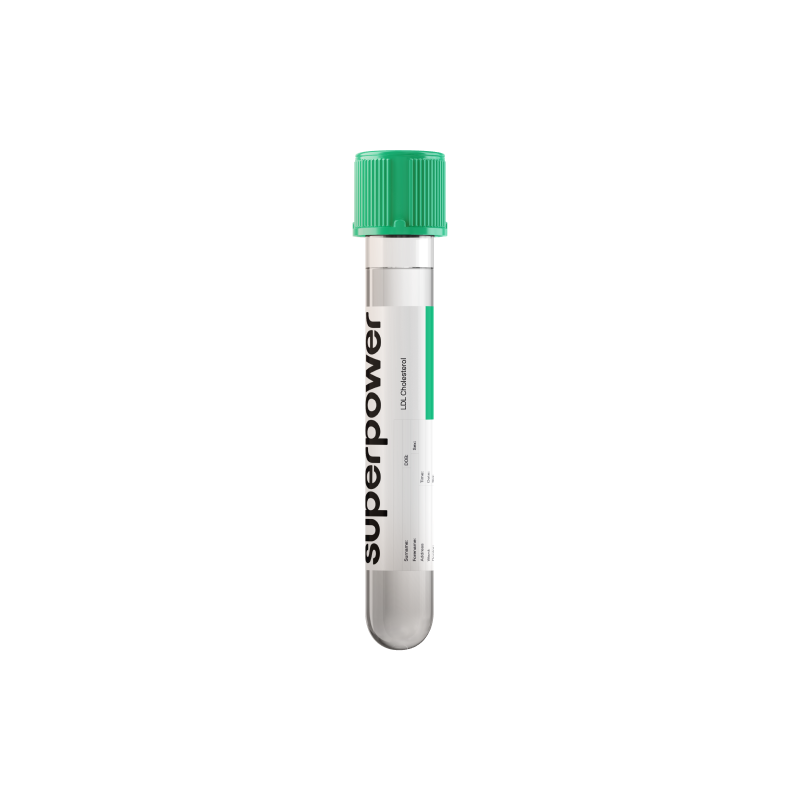Get a clear view of atherogenic cholesterol exposure with LDL-C testing. This core biomarker shows how diet, lifestyle, and therapy influence arterial health—and helps guide prevention strategies across life stages.
Key Benefits
- See your LDL level to gauge plaque buildup and heart risk.
- Spot unhealthy cholesterol patterns that drive atherosclerosis and early cardiovascular disease.
- Flag possible familial hypercholesterolemia when LDL is very high, prompting genetic evaluation.
- Guide statin or nonstatin therapy intensity to lower LDL and event risk.
- Track treatment response and adherence by monitoring LDL changes over time.
- Clarify overall heart risk when combined with age, blood pressure, and diabetes.
- Protect pregnancy planning by optimizing cholesterol before conception; statins are avoided during pregnancy.
- Best interpreted with non-HDL cholesterol or apoB, triglycerides, and lifestyle factors.
What is LDL Cholesterol?
LDL cholesterol is the cholesterol carried in low-density lipoprotein particles (LDL). These particles originate when the liver packages fat and cholesterol into very-low-density lipoprotein (VLDL), which is trimmed in the bloodstream to intermediate-density lipoprotein (IDL) and then LDL. Each LDL particle has one structural protein, apolipoprotein B (apoB), and a core rich in cholesterol esters. On lab reports, “LDL cholesterol” means the amount of cholesterol being transported inside this fleet of LDL particles.
LDL’s role is to deliver cholesterol from the liver to cells throughout the body, supporting cell membranes, steroid hormone production, and other vital processes. Cells take up LDL via the LDL receptor, and the liver clears most circulating particles. LDL cholesterol therefore reflects how much cholesterol is being shipped outward and how efficiently it is removed. When LDL circulates longer than it should, particles can enter artery walls, become modified, and spark plaque formation (atherosclerosis), which is why LDL is central to cardiovascular biology.
Why is LDL Cholesterol important?
LDL cholesterol is the main carrier that delivers cholesterol from the liver to tissues for cell membranes and hormone production. When LDL remains elevated, particles seep into artery walls, trigger inflammation, and build plaque—driving atherosclerosis that threatens the heart, brain, kidneys, and limbs.
Labs classify LDL into optimal, near‑optimal, borderline high, high, and very high. Cardiovascular risk rises stepwise across these categories, and the most protective values generally sit toward the lower end. Typical values reflect a balance between liver production and receptor‑mediated clearance, and don’t cause symptoms.
Very low values usually indicate vigorous clearance or reduced production. This can be genetic, or seen with hyperthyroidism, malabsorption, severe illness, or marked inflammation. Most people feel fine, but if LDL is extremely low due to poor absorption, fat‑soluble vitamin deficiency can lead to fatigue, neuropathy, or easy bruising. In pregnancy, unusually low LDL has been linked to smaller birth weight, though this is uncommon.
High LDL reflects excess hepatic production or impaired clearance (as in familial hypercholesterolemia, hypothyroidism, nephrotic syndrome, or certain medications). Over time it accelerates plaque growth, causing angina, heart attack, stroke, and peripheral artery disease; tendon xanthomas or corneal arcus may appear with very high inherited levels. Risk climbs after menopause in women; in men, erectile dysfunction can signal vascular involvement. In children and teens, markedly high LDL suggests a familial disorder.
Big picture: LDL is a causal driver of atherosclerotic cardiovascular disease. It interlocks with apoB, triglycerides, HDL, lipoprotein(a), thyroid status, kidney function, and inflammation. Keeping LDL toward the low end supports vascular integrity and healthier aging across organ systems.
What Insights Will I Get?
LDL cholesterol estimates the amount of cholesterol carried in low‑density lipoproteins, the main couriers moving cholesterol from the liver to tissues. It reflects how the body packages and clears cholesterol via LDL receptors. Systems-wise, it links membrane integrity, steroid hormone and bile acid synthesis with vascular risk, because excess LDL drives plaque formation in arteries.
Low values usually reflect reduced production or increased clearance of these particles. This can occur with too much thyroid hormone, malnutrition or malabsorption, chronic liver disease, severe illness, or rare genetic variants that lower LDL (familial hypobetalipoproteinemia, PCSK9 loss‑of‑function). Most people feel well, but very low levels may track with inflammation or fat‑soluble vitamin deficiency; in pregnancy, unusually low LDL may signal illness.
Being in range suggests adequate cholesterol delivery without an excessive particle burden. That supports stable cell membranes, hormone and bile synthesis, and metabolic flexibility while keeping arterial risk contained. For cardiovascular risk, consensus generally favors values toward the low end of the adult reference interval.
High values usually reflect reduced LDL receptor–mediated clearance or increased production of VLDL that converts to LDL. Common settings include inherited disorders (familial hypercholesterolemia), too little thyroid hormone, nephrotic syndrome, cholestasis, certain drugs, aging, and the post‑menopausal transition. System effects include arterial retention of apoB particles, plaque growth, and higher risk of heart attack and stroke. In pregnancy, LDL rises physiologically to support fetal needs.
Notes: Age, sex, pregnancy, acute illness (often lowers LDL), and medications influence interpretation. Non‑fasting samples are acceptable, but calculated LDL is unreliable when triglycerides are high; direct LDL or apoB better captures particle burden. Assay methods and labs differ slightly. Brain cholesterol is largely independent of blood LDL.



.svg)



.png)
.png)
.png)
.png)








